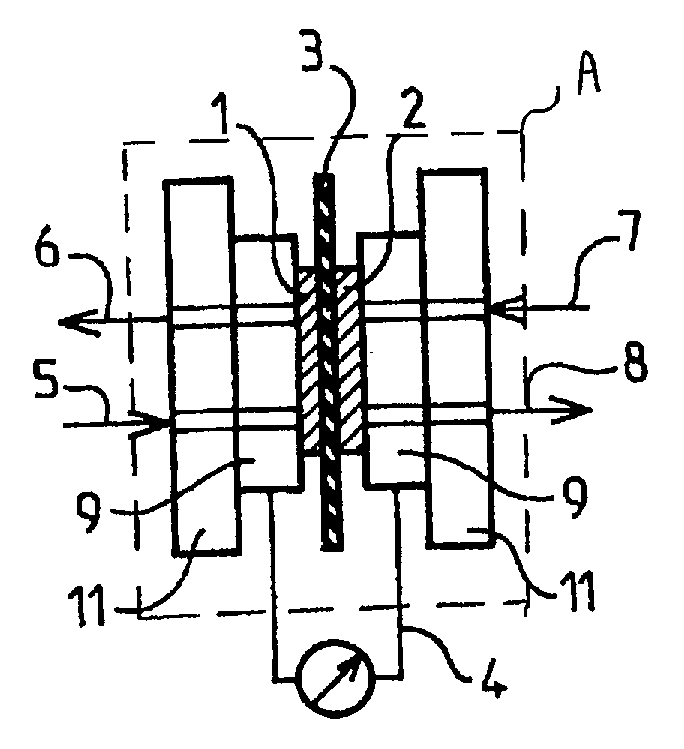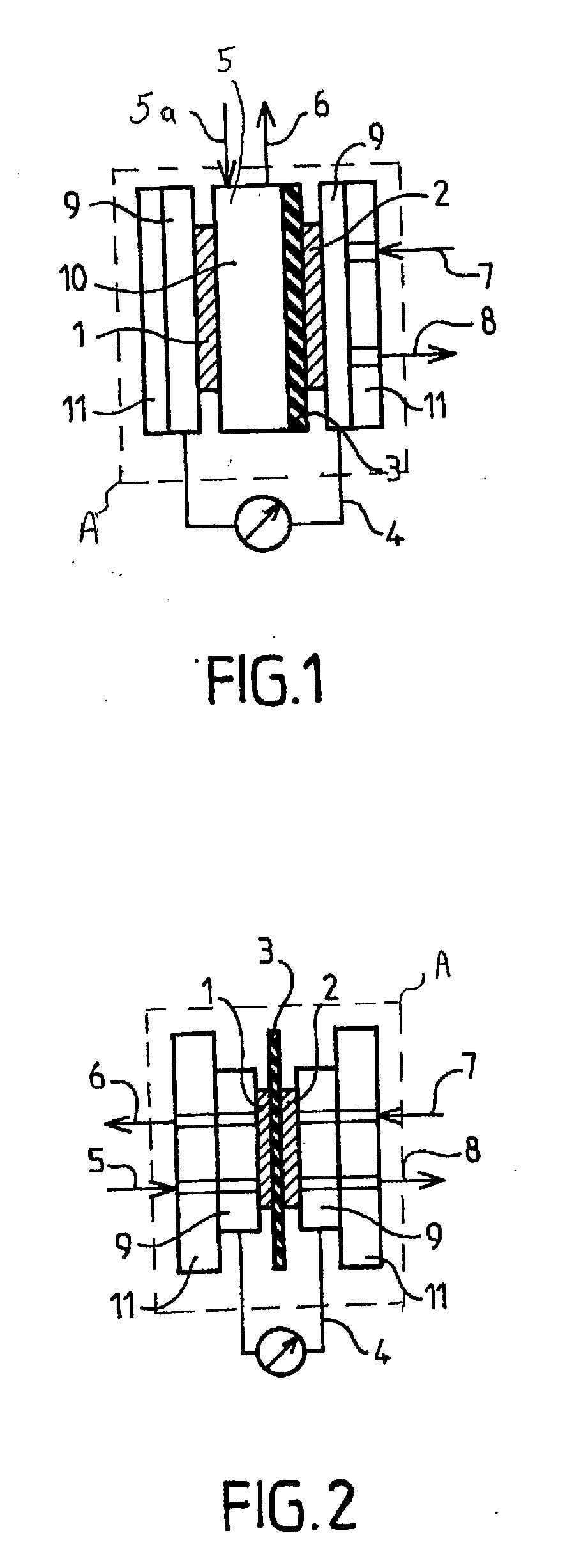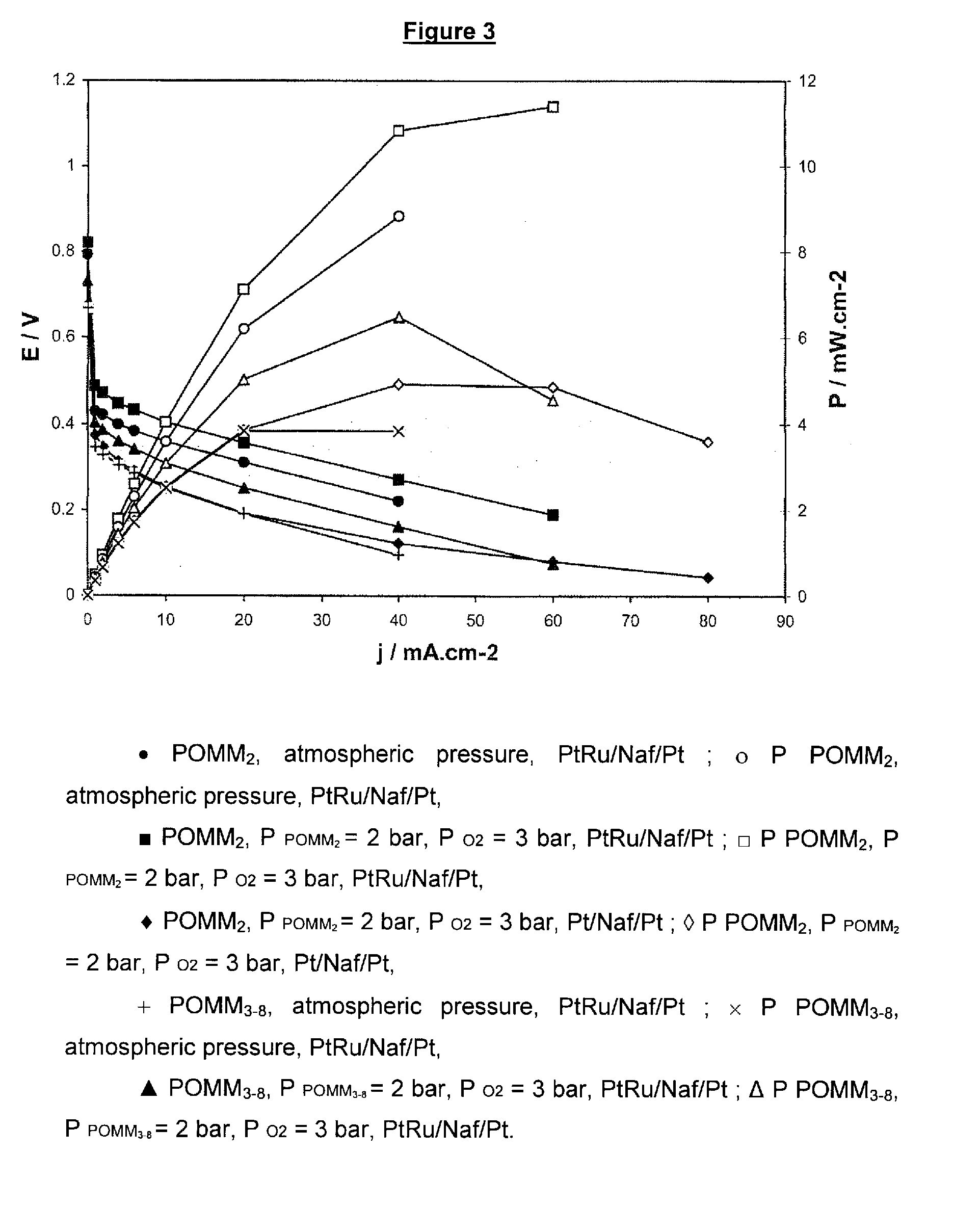Fuel Cells Containing a Fuel Soluble in Aqueous Medium and Having a Boiling Point Higher Than 65'C
a fuel cell and aqueous medium technology, applied in the field of fuel, can solve the problems of methanol having major drawbacks for bulk use, less efficient but more manipulable, and difficult to limi
- Summary
- Abstract
- Description
- Claims
- Application Information
AI Technical Summary
Benefits of technology
Problems solved by technology
Method used
Image
Examples
examples
Polyoxymethylene Dialkyl Ethers
[0110]Examples of polyoxymethylene dialkyl ethers included in the composition of the fuels according to the invention are given in Table I below with their physical characteristics. This table also includes, for comparative purposes, molecules identified by an asterisk * that are not in accordance with the invention.
TABLE IBoilingFlashSolubilityMolarDynamicpointpointin water %massviscosityMolecule° C.Density° C.at 20° C.g · mol−1(cP)CH3—(OCH2)2—OCH31050.95971431106dioxymethylene dimethyl etherCH3—(OCH2)3—OCH31561.024228136trioxymethylene dimethyl etherCH3—(OCH2)4—OCH32021.0671166tetraoxymethylene dimethyl etherC2H5—(OCH2)—OC2H5880.83−56.331040.42 tooxymethylene diethyl ether25° C.C2H5—(OCH2)2—OC2H51400.91334134dioxymethylene diethyl etherC2H5—(OCH2)3—OC2H51850.974.5164trioxymethylene diethyl etheri-C3H7—(OCH2)—Oi-C3H7117-1190.81561.48132oxymethylene diisopropyl ethern-C4H9—(OCH2)—On-C4H91800.835460insoluble160oxymethylene dibutyl etherCH3OH *650.79112t...
examples 1 and 2
[0111]Two fuels according to the invention are used in Examples 1 and 2. The first is a POMM2 with a boiling point of 105° C., a molar mass of 106 g / mol and a mass per unit volume of 0.9597 g / ml. The second is a POMM3-8 with a distillation range of 153 to 268° C., a molar mass of 155.8 g / mol and a mass per unit volume of 1.064 g / ml.
[0112]These two fuels are obtained by reacting methylal with trioxane in the presence of an acidic resin, of the type such as Amberlyst® 15. The reaction medium is subjected to separation steps from which both POMM2 and POMM3-8 are obtained.
[0113]These fuels were tested in direct methanol fuel cells. Two series of tests were performed. In the first, a demonstration fuel cell of “H-TEC” type adapted for university teaching was used. The measurements of change of the voltages and current intensity and density were performed spotwise, i.e. without varying the operating conditions. The second series of tests was performed with a fuel cell of DMFC type operati...
example 1
[0118]The results obtained in Example 1 for the tests in acidic medium are summarized in Table 2 below.
TABLE 2E(mV)Iat(mA · cm−2)ElectrodesMembraneMediumI = 0at E = 0cathode: C—PtNafion H TEC10% MeOH4554.0anode: C—Ptwith Ni grille0.1 M H2SO4cathode: C—PtNafion H TEC10% POMM25255.3anode: C—Ptwith Ni grille0.1 M H2SO4cathode: C—PtNafion 11710% MeOH5952.5anode: C—Pt / Ruwith Ni grille0.1 M H2SO4cathode: C—PtNafion H TEC10% POMM27603.7anode: C—Pt / Ruwith Ni grille0.1 M H2SO4
PUM
| Property | Measurement | Unit |
|---|---|---|
| boiling point | aaaaa | aaaaa |
| flash point | aaaaa | aaaaa |
| flash point | aaaaa | aaaaa |
Abstract
Description
Claims
Application Information
 Login to View More
Login to View More - R&D
- Intellectual Property
- Life Sciences
- Materials
- Tech Scout
- Unparalleled Data Quality
- Higher Quality Content
- 60% Fewer Hallucinations
Browse by: Latest US Patents, China's latest patents, Technical Efficacy Thesaurus, Application Domain, Technology Topic, Popular Technical Reports.
© 2025 PatSnap. All rights reserved.Legal|Privacy policy|Modern Slavery Act Transparency Statement|Sitemap|About US| Contact US: help@patsnap.com



